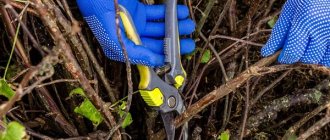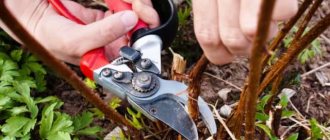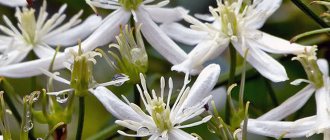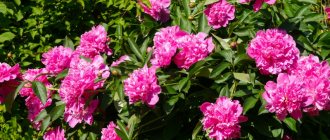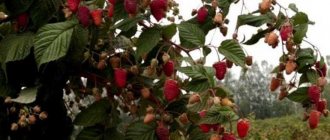What can you treat a pear in the fall?
In the fall, pears are treated against diseases and pests, the pathogens and larvae of which overwinter well in the soil, fallen leaves or damaged tree bark. In the first case, these are fungal diseases that cause enormous damage to fruit trees during the growing season.
- Scab caused by fungal spores causes a lot of trouble for gardeners. The most experienced will notice the first signs in the spring. Platinum leaves become covered with yellowish spots, which eventually swell and burst. The leaves lose their gloss and rich green color, acquiring light green or olive shades. If timely measures are not taken, fungal spores quickly multiply, damaging shoots, inflorescences and fruits. The bark on the branches also swells, becomes deformed or bursts. Brownish growths of irregular shape appear on pears. The plant itself takes on an untidy appearance with gnarled shoots. The fruits accordingly lose their commercial qualities and cannot be stored. Moreover, there is an opinion that they should not be eaten. Autumn is a favorable time for treating pear scab, since you can use strong antifungal drugs without fear for the quality of the fruit.
- Fruit rot can destroy up to 80% of the crop. Moreover, not only pears, but also apple, plum and quince trees are under attack. In the southern regions it threatens peaches and apricots. In spring, spores infect leaves and inflorescences. They acquire a yellow or gray-yellow tint. Peduncles most often fall off. If the infection occurs in the summer, then dark spots appear on the fruits, which seem softer to the touch than other fruits. The spots grow quickly, the pear flesh darkens and softens. Small whitish growths appear around. These are the capsules in which the fungus develops. Over time, they burst, and the wind carries the spores throughout the garden. The fruits are not suitable for consumption or processing. If not removed from the branches, they quickly mummify and become a source of new lesions.
Why do the work every fall?
To achieve a good effect, consistency is necessary, otherwise there will be no point. The fact is that this crop is more susceptible to fungal diseases than others, and pests also often attack it. Batch processing provides a number of advantages:
- Pests and their larvae, which overwinter on the bark and shoots, are destroyed. Already in early spring, they begin to damage the pear, often feeding on flower buds, which can result in losing most of the harvest.
- During this period, insects are most vulnerable and it is easier to fight them. The drugs work effectively because the air temperature is low and solutions do not evaporate from the surface as quickly as in summer.
- Easy to process. The foliage has fallen, nothing prevents you from completely spraying the trunk, branches, and the ground under the tree. It is also convenient to inspect the plant and detect problems.
- No harmful substances enter the fruits. Since the work is carried out after the harvest, the pears are environmentally friendly, and the hazardous substances will be gone before the next season. This is much better than not carrying out prevention and then fighting diseases or pests with chemicals that penetrate the fruit in minimal quantities.
- It is easy to carry out additional work to protect the tree. In addition to spraying, it is necessary to carry out several stages of preparation in order to improve the effect, destroy spores of fungi, insects, and their oviposition.
Advice!
The same treatment should be carried out in the spring before the buds open, then the effect will be best. It is better to start from the youngest age of trees, even when they are not yet bearing fruit. This will ensure rapid development, eliminate growth disturbances, and protect against the occurrence of complex diseases that are difficult to cope with.
Preparing pears for autumn processing
Before you begin to fight rust or scab on a pear in the fall, carry out thorough preparation.
- Cut off all damaged branches;
- Clean the trunk of all kinds of growths, swellings, and flaking bark. It is advisable to cover the root circle with film or tarpaulin to prevent fungal spores from getting into the ground.
- Remove the fruits remaining on the tree.
- Remove fallen leaves and cut shoots and burn them.
- The root circle is weeded out and dug up.
Only comprehensive control measures will help cope with rust and other fungal diseases on pears in the fall.
Protection from bright sun, rodents and frost
Don't forget about whitewashing. It is necessary not only in spring, but also in autumn, so that with the onset of the first sunny spring days the rays do not burn the bark of the trees.
- Ready-made whitewash can be purchased at the store, but you can do it yourself. To do this, we dilute one and a half kilograms of clay and two to two and a half kilograms of ordinary lime in a bucket of water. Using a brush, whiten the trunk from the lower branches to the ground. Young seedlings can be completely whitened. It is better to use a regular paint brush.
- To protect the lower parts of the trunks from rodents, they can be wrapped in spruce branches (needles down) and tied with twine.
- Next, we dig up the tree trunk circles shallowly. We water them thoroughly, then the trees will more easily withstand the approaching frosts.
- After abundant watering, cover these circles with a layer of mulch of about 15-25 cm. This can be peat or sawdust. With this coating, the roots have a better chance of remaining healthy.
- If the winter has little snow, do not forget to shovel snow onto the tree trunk during the winter.
How and with what to treat pears against diseases in the fall
If in the summer gentle methods are used to combat pear diseases, namely the use of biological products and folk remedies, then in the fall you can use chemicals or fungicides.
How to treat pears against rust in the fall
If rust on pear leaves appears closer to autumn, then you should not postpone treatment until spring. Fungal spores wake up quite early and spread quickly. In addition, with large-scale lesions, it is unlikely that it will be possible to cure a pear from rust in one fall. In the fall, spraying of pears with the following compositions is used for treatment:
- A solution of carbamide or urea in a proportion of 0.7 kg of product per 10 liters of water. This solution not only sprays trees, but also treats the soil around them.
- Suspension of colloidal sulfur. It is prepared as follows: 40 grams of powder are thoroughly crushed and dissolved in 1 liter of water. After receiving the suspension, it is poured into a bucket of water. Sulfur does not dissolve well, but settles well on the shoots, providing a healing and protective effect.
- The drug “Svor” shows good results in treating pear rust in the fall, especially if it is used together with the antibacterial agent “Fitoldavin”.
To prevent rust (and it should be done without fail if juniper grows on the site) use copper-containing preparations - Bordeaux mixture or copper sulfate solution.
Attention!
Before processing, be sure to inspect the shoots. Diseased ones are cut to a ring or 5-7 cm below the affected area. The growths are cleared from the trunk and skeletal branches.
How to treat pears for scab in the fall
Scab is an extremely dangerous disease because it spreads quickly. Many garden crops suffer from it, for example gooseberries. And fungal spores have the ability to adapt to the effects of drugs.
Fungicides “Horus” and “Tolsin-M” will help fight scab on pears in the fall. These drugs have a powerful effect and can accumulate in plant tissues. Therefore, they are not recommended for use during the growing season. In the fall, 2-3 sprayings are carried out, alternating them with more gentle antifungal agents - Bordeaux mixture or Fitosporin. They should also treat the soil under the pears.
Autumn moisture-charging irrigation
It is also called “moisture-recharging” irrigation or “winter” irrigation.
Autumn moisture-recharging watering of a pear is another useful measure that allows you to better prepare the tree for winter by “filling” it with moisture.
The fact is that moist soil freezes less and has greater thermal conductivity, in other words, heat from the lower layers of the soil will warm the roots of your pear during the cold period.
Thus, moisture-charging irrigation is recommended for all fruit trees and berry bushes.
When?
- With the beginning or after leaf fall, on the eve of cold weather (at positive temperatures).
When is winter watering especially necessary?
- If you have sandy loam soil and autumn does not indulge in frequent and heavy rains, and the winter has little snow.
Worth understanding! Of course, if autumn is very rainy, then you can completely do without moisture-recharging irrigation.
How much water is required?
- Approximately 40-100 liters of water per 1 square meter of tree trunk circle (for young people - 40-50 liters, for adults - 80-100 liters), i.e. you need to calculate the area based on the projection of the crown (its perimeter). The more mature and massive your tree is, the more water will be required: approximately 50 to 200 liters.
Advice! Naturally, you don’t need to carry any buckets: take the hose and move it around the tree trunk (and first measure how many minutes it takes to fill one 10-liter bucket. For example, if it takes 30 seconds, then 5-10 minutes will be enough).
And after watering (for example, the next day), it is also very advisable to loosen the soil in the tree trunk circle, because loose soil freezes less.
Of course, if you have a good layer of turf under the pear or just grass (lawn) growing, then you don’t need to touch it.
Rules for treating pears against pests in the fall
Autumn is perhaps the best period for treating pears for pests. Don't think that most of them will die in winter. If in the summer traces of the vital activity of pear mites or aphids were noticed on the trees, then the trees are sprayed with insecticides such as Acrobat, Inta-Vir or Karate.
Treatment is carried out by spraying or spraying a solution prepared according to the instructions.
Purposes of the procedure
Pear is a fruit tree. Like other fruit plants, the planting needs regular care. Autumn processing of pears is mandatory. Pests love fruit plants. They can attack both the tree itself and the resulting crop. Pests can be found on foliage, in folds of bark, in buds or flower ovaries. When the fruits ripen, pests are also found there. This leads to complete or partial loss of the crop. When infected, pears drop before they ripen. Carrion becomes a source of infection for healthy plants.
Pests also affect the general condition of the plant. Leaves dry out and fall off prematurely. We must also not forget that some insects act as carriers of diseases. If an infection occurs, there is a risk that the tree will die.
Spraying against pests in the fall helps to neutralize insects that have gone into the ground for the winter. It is this procedure that reduces the risk of diseases and insects. Additionally, this measure ensures resistance to frost. The plant is protected from the negative effects of external factors. Proper spraying will completely destroy all pests. Next season it will be possible to get the maximum possible amount of harvest.
Rules for processing pears in autumn for winter
Almost all treatments are carried out by generously spraying preparations on the shoots and spraying or watering the root circle with them. It is better to use a garden sprayer with a long hose and a large capacity container.
Pears are processed in dry and windless weather. It is advisable that there is no precipitation in the next 24 hours. In this case, the solution will have time to absorb and activate its effect.
To perform work, closed clothing and personal protective equipment are used: gloves, goggles, respirators. Before processing, you should carefully read the instructions for use of a particular drug and be careful. After all, large areas will have to be processed.
Recommendations for processing trees
First, the amount of work to be done is assessed. One young tree requires about 2 liters of the side mixture, and one adult tree requires about 9-10 liters of medicine. Spraying is carried out in a protective suit. The package with the purchased drug indicates the dosage and procedure for use. The information is provided in advance. Do not exceed the recommended concentration level. Other recommendations:
- processing of fruit trees is carried out in dry and windless weather;
- the composition is sprayed in the evening to increase the duration of its action;
- applications begin from the top point of the tree, gradually descending in a circle;
- the prepared solution wets as much of the crown as possible.
The trunk and part at the root are treated, because some insect pests prefer the lower parts of the tree.
| Problem | Description | Symptoms | How to fight |
| Rust | The fungal pathogen can only be destroyed at an early stage; if the disease has become acute, the tree must be cut down | Affected shoots must be cut 7 cm below the damaged area | At the initial stage, green spaces and tree trunks are treated with a solution of copper sulfate or a solution of urea 700 g per 10 liters of water |
| Mite | The insect feeds on the sap of the plant, gradually killing it | Leaf blades are covered with characteristic swellings | Use the drug “Inta-Vir”, “Decis” before the formation of kidneys |
| Flower beetle | The weevil is highly resistant to chemicals | Insects are visible on the crown and trunk | Sticky tape is placed along the trunk, the trunk and leaves are sprayed with strong-smelling herbs - the pear will not be harmed, and the beetle will go looking for another source of food |
| Curling leaves | Caused by lack of water or nutrition, pest or disease activity | Depends on the root cause, for example, if the tree is infested with aphids, there are noticeable white spots on the trunk and leaves | Treatment is carried out using “Iskra”, “Kinmiks”, “Fitoverm” in the dosage indicated on the package immediately after flowering. |
| Scab | The fungus attacks already ripe fruits | Dark velvety coating, round spots | Stage I - treatment with a 3% solution of Bordeaux mixture, Stage II - after flowering, use the same drug (1%), Stage III - after 3 weeks, use any fungicide at the rate of 350 g per 1 liter of water, so that no trace remains of the scab |
Traditional preventive methods are used exclusively as an additional remedy. Wood ash has proven itself well. Take 200 g of product per 10 liters of water. The mixture is infused for 24 hours, and then poured into a spray bottle. A few minutes before the start of treatment, add 50 g of finely grated laundry soap to the composition.
On a note!
Folk preparations for treating planted pears in the fall against pests and diseases are prepared immediately before use. The finished composition cannot be stored. It quickly loses its properties.
Care after landing
From the moment the pear is planted until the end of the dacha season, there is still some time left during which time you need to help the young tree adapt, take root and prepare for winter. Caring for a young pear in the fall comes down to several activities:
- maintaining soil moisture - the roots should not dry out, but the soil should not become waterlogged, so watering is carried out in accordance with precipitation;
- preventive treatment against pests and diseases, for which insecticides and fungicides are used;
- loosening the top layer of soil. This operation will provide the tree with oxygen - the earth will not be compacted too tightly in the snowy winter;
- weeding weeds if they have already appeared in the tree trunk area.
Preparing for winter
A young pear needs careful preparation for the first winter on the site. If there are already branches on it, they need to be carefully collected together and tied to a peg. It is very important to provide shelter for the trunk from frost damage. To do this, it is wrapped in covering material that allows air to pass through, or pieces of cotton fabric. If it is possible to come to the site in winter, then it is necessary to cover the tree with snow.
In winter, small rodents like to eat the bark of young fruit trees, so to protect against them, the pear trunk is wrapped in fine mesh or treated with a repellent mixture.
The simplest mixture can be prepared by mixing clay and mullein in equal proportions. The smell emanating from the treated wood will drive away rodents. Another way to protect against them is spruce branches, which are laid out around the pear.
The first rule is to clean the area, take care of the tree
Before you start seriously preparing your pear trees for frost and then the harsh winter months, you need to tidy up the area around the trees. What should you pay attention to first?
- With the onset of autumn, it is necessary to collect all the fruits that have fallen from the branches. There are usually a lot of them. There are varieties of pears whose fruits do not stay on the tree long enough after ripening. Sometimes it picks a lot of pears after windy weather.
- Fruits on the ground, as well as fallen leaves, begin to rot quickly, so you need to remove everything as quickly as possible. Spoiled pears can harbor harmful insects, as well as viral infections, scab and rot.
- Examine the tree carefully. Trim dried, broken or damaged branches. It is also important to inspect the trunk and the condition of the bark. If unevenness, damage or wounds are found on the surface, then clean the area until healthy bark begins to appear.
- All damaged areas on the pear must be treated with copper sulfate (on the bark) and garden pitch. This will protect the tree and protect it from infection entering the tissue.
When all the work is done, then with a rake all the rotten fruits, branches and pieces of bark need to be raked into one pile. If the tree is healthy, then you can put all the garbage in the compost heap. But if the pear has diseases, then all the remains must be taken out of the garden and burned.
Why process a pear
Pear processing is necessary for the reason that parasites attack the tree and destroy it. They destroy not only the culture, but also the fruits. Pests live on leaves, bark, ovaries and buds. The parasite larvae gradually spread on ripe fruits, which spoils the harvest. In addition, fruits affected by pests often do not ripen and begin to fall earlier than expected.
The entire tree suffers from parasites. Invasion of entire colonies often occurs, which causes leaf wilting and early leaf fall. The situation may be aggravated by the fact that insects can become carriers of various diseases in the garden. Therefore, the pear needs to be treated several times during the season with special pest control agents. This approach will effectively solve the problem, because helps destroy unwanted “neighbors” at all stages of their development.
How to plant a pear tree correctly - a step-by-step guide
Before you plant a pear, you need to choose a place suitable for this heat-loving crop. The main requirements for cultivation are good sun exposure from all sides and the absence of through cold winds, so the pear is planted on the south side of the site.
Before digging a planting hole, it is necessary to consider one more important factor - there should be no tall trees nearby that will subsequently shade the pear, compete for nutrients and come into contact with its crown.
Pit preparation
Taking into account the root system of the pear seedling, which during the first years will consume all the necessary nutrients from the mixture placed in the hole during planting, its dimensions will be 60 cm in depth and 1 m in diameter. The steep walls of the pit will ensure the necessary shrinkage of the earth after planting. When planting, you will need the top layer of soil discarded when digging the planting site, and the soil removed from the lower layers will not be useful.
The pit is filled with a nutrient mixture. To prepare it, you need to add mineral fertilizers to 6 liters of compost: 30 g of potassium salt and 60 g of superphosphate. Under no circumstances should nitrogen-containing fertilizers be added to the planting hole. In order for a special microclimate to form inside the substrate and the chemicals not to burn the young pear roots, the planting pit is prepared in advance - in late spring - early summer.
Landing
Planting a pear seedling takes place in stages. Below are detailed instructions for planting a fruit tree at your summer cottage.
- You need to form a small mound inside the hole, after which you pour it generously and wait for the water to settle.
- The seedling must be prepared for planting: if it has an open root system and it has dried out a little, the pear is placed in water for 12...24 hours.
- To install the seedling in the planting hole, you may need the help of another person. Then one will hold the pear strictly vertically by the trunk, and the second will place the root system in the ground.
- The roots of the seedling are straightened with extreme care and spread along the slopes of the mound in the hole. You can start burying a seedling only after making sure that its root collar will be located 5 cm above the ground surface.
- After installing the pear, its roots begin to be buried, carefully but quite tightly, compacting the soil so that no air voids remain.
- After planting, the trunk of the tree is tied with a soft cloth to a peg.
- It is necessary to make a hole around the pear so that when watering the water does not flow down the sides, but goes directly to the roots. Post-planting watering should be plentiful - 2...3 buckets of water are poured onto one young seedling.
- The planting of the pear is completed by mulching the tree trunk circle. Sawdust and peat can be used as mulch. Mulching prevents premature evaporation of moisture from the soil.
There are two diametrically opposed opinions regarding pruning pear seedlings during planting.
- Some argue that healing the wound at the cut site takes a lot of effort from the plant, which is intended to prepare for winter.
- Others suggest that pruning annual pear seedlings stimulates root growth.
After weighing all the pros and cons, each gardener determines for himself whether he needs to shorten the top of the seedling or not.
Proper autumn planting of a pear will ensure its good survival rate, rapid development and high yields in a few years.
If groundwater is nearby
A particular problem when planting pears can be the close location of groundwater to the surface. In such areas, it will not be possible to grow a crop without the use of special agrotechnical techniques.
- In order to lower the groundwater level, you can organize a drainage ditch, drain the area, or dig a small lake in the lowest area of the dacha. The method of artificially lowering the water level is very labor-intensive and expensive.
- You can plant a pear on a hill. To do this, a hill is formed from imported soil. You can put slate at the bottom of the hole, which will prevent the root system from deepening into the soil and force it to branch horizontally.
The main sign that the root system has reached groundwater is the drying of the tops of the pear.
Features and timing of autumn pear pruning
When to prune a pear, each gardener decides for himself. In central Russia, it is recommended to do this after harvesting - at the end of August or beginning of September. In the southern regions of the country, the haircut can be postponed until October. But you shouldn’t delay the procedure too much, because... wounds need time to heal before cold weather sets in.
Astrologers do not advise pruning during the waxing Moon. At this time, the juices flow upward, and the tree spends a lot of time and effort on healing the cuts. It is better to choose the days of the waning moon (ideally, phase 4).
The Lunar calendar will help you choose a good day for pear pruning.
- Gardener's lunar calendar 2021 - favorable days for autumn pruning of plants
Do you follow the lunar calendar in your gardening work? Then find out which days are suitable for autumn pruning of fruit and ornamental crops.
To understand how to properly prune a pear after summer, you need to understand that the autumn “haircut” is, first of all, of a sanitary nature. Since the end of August, the movement of juices has slowed down, although it is still far from a complete stop. The tree will be able to tighten the cut points, but to do this it will have to expend the energy it has stored for the winter. In order not to deplete the reserves of the pear and not leave it without useful substances, autumn pruning should be extremely gentle.
If you missed the deadline for pear pruning, it is better to postpone the procedure until spring. Otherwise, the tree may not cope with stress and will not survive the winter well.
Before moving on to specific pear pruning schemes, it would be a good idea to familiarize yourself with the general rules and nuances.
- Choose dry days for pruning . Rainy weather increases the risk of wound infection. After the onset of frost, pruning is no longer carried out. The optimal air temperature is not lower than 8°C.
- Use a garden ladder . Pear wood is denser and harder than apple wood, but at the same time it is more fragile and therefore susceptible to breakage. This means that climbing skeletal branches during the sanitary procedure is strictly prohibited.
- Don't overdo it with pruning . Do not remove more than 25% of the total wood mass at one time. If the tree needs major pruning, postpone the procedure until early spring, and in the fall, only shorten the branches slightly (by about a quarter of their length). The cuts are susceptible to freezing, which means that heavy pruning can cause the tree to disappear. In addition, severe pruning of pear trees at a young age delays the onset of fruiting.
- Cut out skeletal shoots more than 5-7 cm in diameter in three stages . First make a cut from below, otherwise the branch will break under its own weight and the bark will tear. Then saw the top of the branch, leaving a stump. When you have already gotten rid of the main part of the branch, you can begin the leveling cut.
- Process all cuts . The cuts should be covered with garden varnish or drying oil-based compounds. Adult dry branches are treated immediately, but young ones need to be given about a day to dry.
- Do not leave cut branches on the site . Autumn pruning is often associated with freeing the tree from branches affected by pests. Therefore, it is better to get rid of them immediately, for example, by burning them.
Preparing young pears
Firstly, when planting, a wooden peg must be driven in, to which the seedling is tied. It is not recommended to use a metal support, since in frosty conditions the bark may stick to the metal and damage its structure.
All shoots must be tied to the main trunk so that the winds do not break the fragile branches. Sometimes, if the tree is planted in an open area, each branch is tied with soft rope to a separate stake to provide stability to the tree.
The tree trunk circle also needs to be loosened and watered abundantly. Next add a layer of mulch. Use peat and sawdust, and the layer must be made at least 30 cm. Snow must also be raked to the roots more often. But in the spring, when it begins to melt, glaciation of the upper layer is possible. It needs to be removed so that oxygen penetrates to the roots.
It is strictly not recommended to replant young trees before the onset of cold weather. This is a lot of stress for the pear. Subsequently, after such manipulations, the pear may not have time to prepare for winter, will not tolerate stress and may die.
Pear transplant
There are situations when it becomes necessary to plant or transplant a young tree. If you are carrying out the procedure in an area where winter is not too cold, then plant no later than a month before the onset of the first frost.
- It is important that by the beginning of the event the fruiting period has ended, the harvest has been fully harvested, and the foliage has fallen.
- The young tree must be completely healthy and strong.
- The planting hole should be dug at least 14 days in advance so that the ground subsides a little and the soil is saturated with oxygen.
- You cannot put fresh humus or peat at the bottom; only compost will do. Make a mound of fertile, nutritious soil. Place a seedling on it.
- Straighten the root shoots and gradually cover with soil. It is important that there are no voids in the root system, so compact the soil with your hands. The root collar should be 3 - 5 cm above the soil level.
- Drive a wooden peg into the hole next to the seedling and tie the plant to it.
After planting, water the tree with 10 - 20 liters of water. Then prepare it for cold weather, like all other garden trees, especially mature pears.
